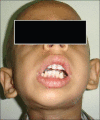Temporomandibular Joint Ankylosis: "A Pediatric Difficult Airway Management"
- PMID: 29628599
- PMCID: PMC5872883
- DOI: 10.4103/aer.AER_122_17
Temporomandibular Joint Ankylosis: "A Pediatric Difficult Airway Management"
Abstract
Intubating a pediatric patient with temporomandibular joint ankylosis is a daunting task, and it becomes more challenging with limited mouth opening. Fiberoptic nasotracheal intubation technique is considered a gold standard. We describe an improvised technique of securing airway in the absence of appropriate-sized fiberoptic scope. The endotracheal tube inserted in the left nostril for maintaining depth of anesthesia was advanced under vision by the fiberoptic scope inserted into the right nostril, and with external laryngeal manipulation, the airway was secured with no complications.
Keywords: Airway management; bronchoscopy; pediatrics; temporomandibular ankylosis.
Conflict of interest statement
There are no conflicts of interest.
Figures
References
-
- Morray JP, Geiduschek JM, Caplan RA, Posner KL, Gild WM, Cheney FW, et al. A comparison of pediatric and adult anesthesia closed malpractice claims. Anesthesiology. 1993;78:461–7. - PubMed
-
- Santos AP, Mathias LA, Gozzani JL, Watanabe M. Difficult intubation in children: Applicability of the mallampati index. Rev Bras Anestesiol. 2011;61:156–62. - PubMed
-
- Shah FR, Sharma KR, Hilloowalla RN, Karandikar AD. Anaesthetic considerations of temporomandibular joint ankylosis with obstructive sleep apnoea: A case report. J Indian Soc Pedod Prev Dent. 2002;20:16–20. - PubMed
-
- Kulkarni J, Shah K, Khan AA, Khaire S. Anaesthetc management of temporomandibular joint ankylosis without fibreoptic bronchoscope – A review of 31 cases. IOSR J Dent Med Sci. 2013;8:50–4.
-
- Brooks P, Ree R, Rosen D, Ansermino M. Canadian pediatric anesthesiologists prefer inhalational anesthesia to manage difficult airways. Can J Anaesth. 2005;52:285–90. - PubMed
Publication types
LinkOut - more resources
Full Text Sources
Other Literature Sources


